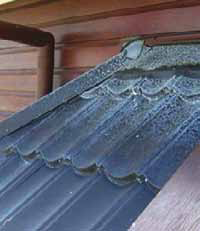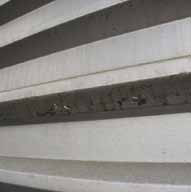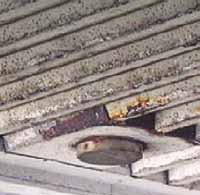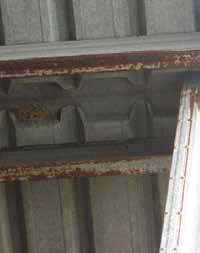What Is The Problem With Unwashed Areas?
Article by Stuart Hayman and Stuart Thomson
Designers have usually many other priorities to concern themselves with than details about unwashed areas, however the purpose of this article is to raise awareness of this potential problem. The description of an unwashed area is given in the NZMRM Code of Practice 2.6.7. It is mentioned 41 times in that document so we think it is pretty important..bmp)
.bmp)
The drawing 2.6.7.A. shows the circumstance to be ‘average’ i.e. with an average wind blowing and the ‘washing’ referred to is rain, whereas 2.6.7.B. shows a practical example of such an unwashed area.
N.B. This detail is verboten by E2/ AS1 8.1.3.1. however there is a way to do it!!
Why should this be a problem?
All building materials start to go off the moment they are exposed to the elements, however some are more sensitive to dirt and contaminants than others. While all materials have their own problems the focus of this article is on metal roof and wall cladding. One way to minimise this deterioration is to wash them like our cars, or windows or even clothes. Rain does this automatically and regularly however those places that do not receive this benefit require help to reach their expected longevity potential. This could be achieved by design or it could be by the continuing expense of regular maintenance.
Most parts of New Zealand are exposed to airborne corrosive materials carried in the air. The distance airborne marine salt is carried varies significantly with local wind patterns and in some locations salt may be carried more than 30kms inland. In agricultural areas, the dust may contain fertiliser particles. Even in cities (nearly all of which are close to the sea) industrial pollution can carry minute particles of chemicals. Any building surface exposed to contaminating air will allow the particles to coat the surfaces which form a fine layer of dust on the surface containing a cocktail of salts and chemicals, some more damaging than others. Particularly on humid days and nights, the typically hygroscopic particles absorb moisture attracting and holding corrosive materials that end up as a very concentrated solution or paste sitting on the surface. If it is washed off then that’s fine, but if its not?
Logically, the severity of the environment determines the severity of the corrosion. Unwashed areas can deteriorate more than four times the rate of washed areas as a small microclimate is produced in areas such as under air conditioning units or solar collectors, unless they have a cricket type penetration design that avoids the unwashed area. Galvanised and Zinc/Aluminium alloy coated steels and aluminium actually need a small amount of contaminants to start the oxidation or carbonation process which gives them ‘natural protection; but not too much! Painted metal surfaces are more sensitive to this
dirt build-up than plain metals for the reason that they need to be able to “breathe” and although the paint finishes are water resistant they are not totally impermeable to water and water vapour. In places that are not exposed to direct rainfall, soluble corrosive material can find its way through the paint, and be recognised as blistering, with corrosion products underneath. Eventually if left untreated, this will lead to deterioration of the protective metallic coating and ultimately to failure by perforation. While painting metal roof and wall cladding primarily provides an aesthetic appeal, it also provides protection from the elements but only providing it is cared for by design or maintenance. This is largely the designer’s prerogative –not to design unwashed areas or plan a maintenance programme for the new owner. Some of these areas can be tricky and some ingenuity has to be exercised to avoid premature deterioration.
HORIZONTAL CLADDING
.bmp) Horizontal cladding must only be used in exposed areas to prevent the build-up of dirt or a strict maintenance programme must be set up and adhered to. Also the drip edge of painted metal is vulnerable because build-up of pre-treatment, primer and top coat at the extreme edge of the sheet.
Horizontal cladding must only be used in exposed areas to prevent the build-up of dirt or a strict maintenance programme must be set up and adhered to. Also the drip edge of painted metal is vulnerable because build-up of pre-treatment, primer and top coat at the extreme edge of the sheet.
In the same way garage doors and their flashings need regular care. Garage roller-doors being horizontal suffer from their inherent ‘protected’ design and need to be washed regularly. The joints in sectional garage doors are not so obvious but they too are vulnerable.
OVERHANGS
The overhang erroneously favoured by the DBH as a means of weather tightness is a major cause of corrosion, but only when the designer has placed the metal cladding in the unwashed area. Not only the wall cladding below it but the soffit lining suffers as well. Unlined soffits, horizontal or sloping, where the underside of the roof is exposed, curved roof soffits and curved covers to walkways – crimped or otherwise, canopies above load-out doors and service station canopies are all subject to a harsh environment so they must be treated as a special maintenance cases.




